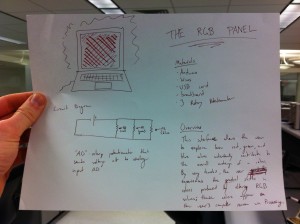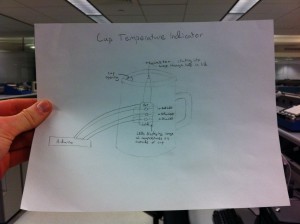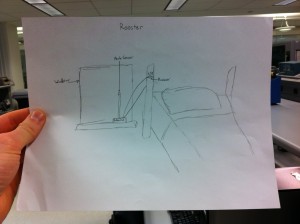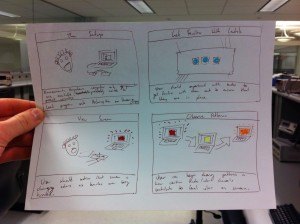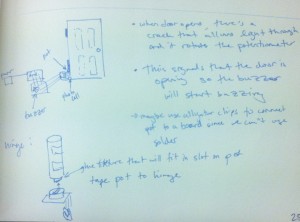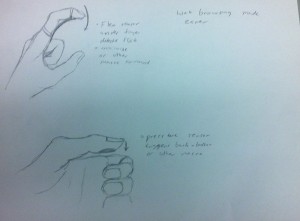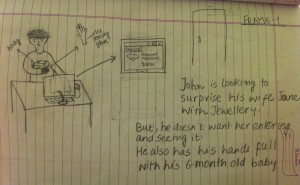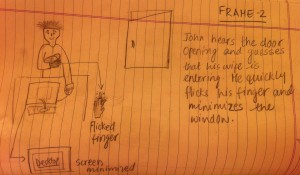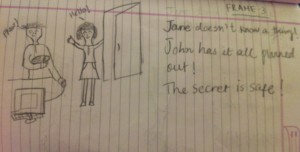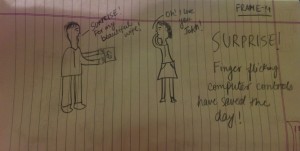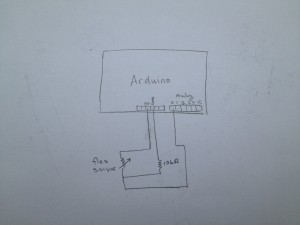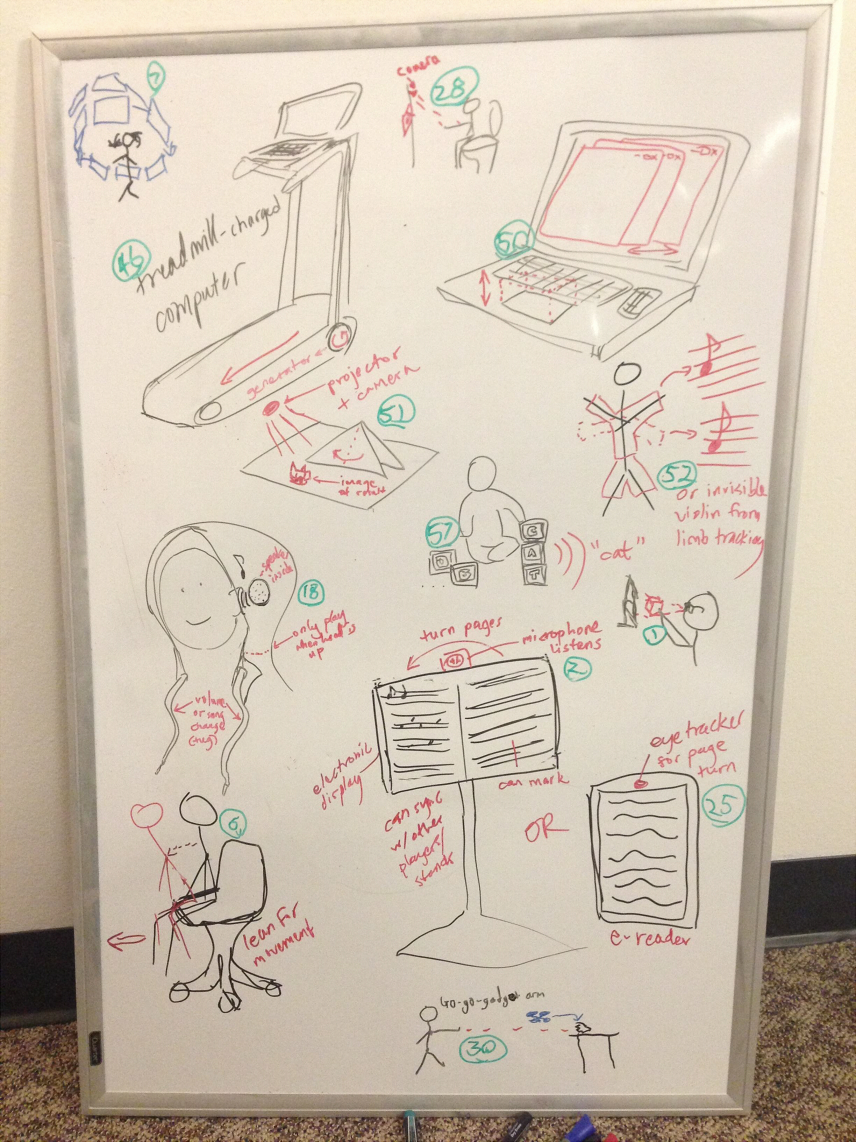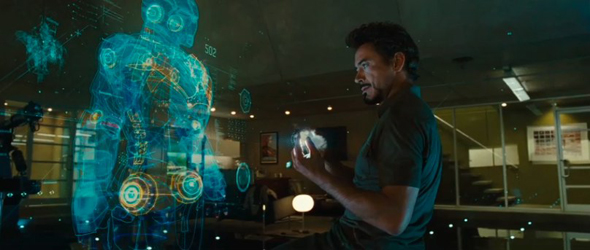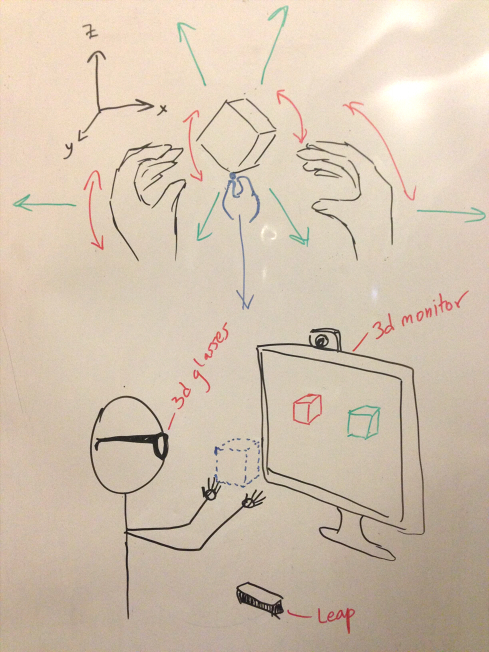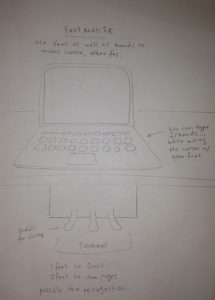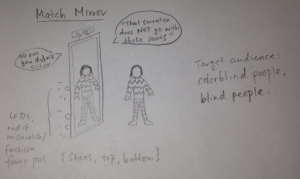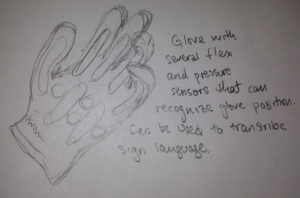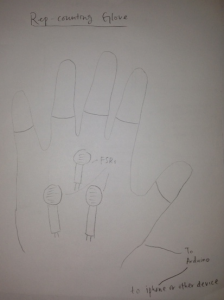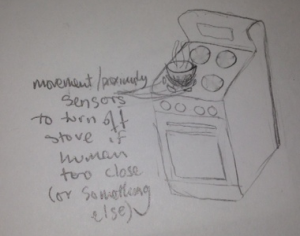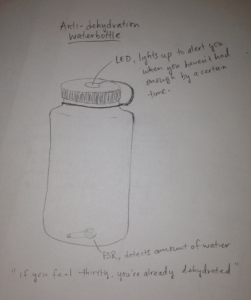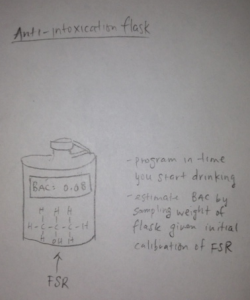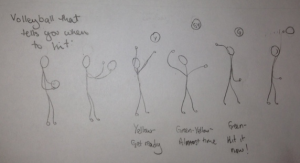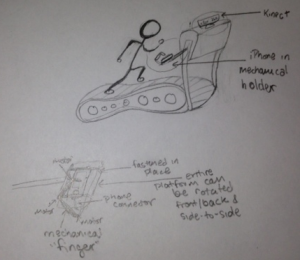Brainstormed Ideas:
1. Posture helper—Detects and notifies you when you do not have the right posture.
2. Push-up monitor—detects motion along your body as you do push-up and ensures that your push-up form is at tip-top shape; can also add some sort of motivational game that helps improve your form
3. Built-in shoe sensor—help improve the monitoring of a runner; detects how many steps you have taken, how fast you have taken them, distance, and impact, and compares to previous runs/makes suggestions about how to avoid injury
4. Alarm clock stimulator—Uses a combination of features: tactical, sound, touch, and smell to guarantee that user wakes up
5. Sleep-movement regulator— detects lapses in the REM cycle; plays soothing sounds when movement is detected to help user sleep better
6. Classroom alarm clock— detects when a student is beginning to fall asleep and uses sensory stimulation such as vibration to keep the student awake
7. Pen that does not write, but senses pressure and shapes and identifies writing so you can write on any surface and it will compile it into a digital document.
8. Proximity reminder—signals to you what types or errands or tasks you should do when you’re within a certain area (or within proximity of something like the grocery store)
9. Office-hour scheduler—helps coordinate meetings with other people (allow them to see your location)
10. Parking-locator— Indicates where you have parked and sends you the location; also can issue an alarm that emits from the car if button is pressed (alarm button attached to key only works within small distance)
11. Item-locator—helps locate most valuable misplaced items simultaneously (cell-phone, wallet, keys, etc.)
12. Smart shower: before shower, collects data from skin contact and determines water
temperature and duration needed for skin’s dryness and dirtiness
13. Expanding on #12, during the shower, skin sensor that prevents skin from becoming too hot (proven to be unhealthy), gives you/shower feedback)
14. Small wearable sensor worn on skin that detects skin’s dryness and suggests when lotion should be applied.
15. Better sensing techniques for a blind person—modify a cane with additional detection of distance and sound/touch feedback
16. Breath detection—resolves the problem of bad breath; detects the chemical composition of breath and warns user whether or not they need mints or breath-refreshers
17. Hydration detection— building off of #16, resolves the problem of bad dehydration; detects the chemical composition of breath and warns user whether or not they need to drink water
18. Bacteria detecting utensils—prevent user from ever getting stomach-viruses by warning user whether the food they are picking up with their utensil has potentially harmful bacteria.
19. Interactive learning game (e.g. for multiplication tables) with sensory feedback such as vibration, sounds, or smells that correspond to the associations (helps user remember by using multiple senses)
20. Visual note-taking: Records what you write, detects circled terms, and creates a digital version of your notes with images of the terms you circled. Could also automatically detect keywords in your notes and create a “collage” for visual learners/quick refreshing.
21. Glasses that display notifications on the lenses, could be used for emails, schedule notifications.
22. Discreet texting device: personal projector/video camera that projects a keyboard onto the surface in front of you, detects which letters you press, and allows you to send texts discreetly during classes, meetings, etc.
23. Discreet device attached to arm or clothing that warns you when your stocks are going down with vibrations, includes a quick sell button or a more complex interface based on personal projector (see texting device).
24. An accelerometer or flex sensor for hand and arm motions that senses and remembers if you’ve done certain actions (locking doors, closing door, etc)
25. Commute to-do list — user uploads to-do list (quick calls, small articles/memos to read), and device detects traffic/stop-and-go motion of car and suggests appropriate to-do list for commute (may give warning/turn off when car is in motion)
26. Shoe/step sensor — worn inside shoe, gives information about step style, detects pronation and supination and recommends appropriate shoes/insoles
27. Smart closet — takes data about weather and suggests appropriate clothing (if complete integrated system, might move those pieces of clothing to front/middle of closet)
28. Habit-fixer — a small accelerometer device that is affixed to appropriate part of body and detects habits that you want to fix (biting nails, jiggling legs)
29. Cell phone as Mouse – attach your cell phone to your computer, and then use that as a mouse / menu options to reduce clutter on the screen, use ultrasonic information too.
30. Calorie detector – probes food items and determines the nutrition information.
31. Smart Room – changes music and TV upon entering a room according to predetermined tastes of the users who enter (using device carried by user or mobile data). If more than one user enters, it will figure out the common interests among them all.
32. Athletic-form helper – for any type of athletic activity, a certain technique is necessary; use some sensors that detect the motion of the user, and the movement can be shown through a video feed, and thus, the form of the athlete can be improved (ice skating, pitching a baseball, etc.)
33. Hand sensor for playing violin, guitar, etc, that detects hand posture and gives advice on improvement, also can download specific pieces and it can tell you which finger intervals were wrong
34. Orchestra section communication device: attaches to music stands, detects when changes are made to music of principal stand, and notifies rest of stands about type of change (bowing, etc) and location (measure number)
35. Building off of #34, Kinect-type device attached to music stand that detects when bowings within section are not coordinated.
36. Contextual music page-turner: detects the notes that are being played or sung and lights up the corresponding notes on the sheet music; mechanically flips the pages when the end of the sheet music page is detected
37. Instrument upkeep device — small device that can be run over stringed instruments to detect moisture of wood, rosin/oil buildup, and state of varnish to detect when humidifier should be used or cleaning/varnishing should be done (already analog devices fro humidity, but need more exact/holistic sensor)
38. Urine characterization – takes input of color, chemicals, etc. and determines certain characteristics about your healthiness, and suggests improvements.
39. Virtual mouse – acts like a mouse, you can move around empty space to control the mouse on a computer.
40. Smart baking pan — detects which areas have been greased, so you can cover whole surface and grease enough
41. Smart beat – Creates music based on your interactions with the environment (if you are walking, takes up the beat of your steps)
42. Remote button pusher – you can have a button that will adapt to whatever device you want to click (camera so you don’t need a self-timer, turn off a light from far away, etc.)
43. Handheld scanner — scan a physical page (notes, etc), and uploads it with good design (checks alignment, spacing, etc)
44. Interactive scanner for physical books — looks like (and may act as ) clip-on reading lamp, but detects when words are underlined or notes are taken, and scans those pages for easy recap of significant passages
45. Individual temperature-sensing thermostat — has infrared sensor that detects the temperature of individuals inside the room and adjusts (if someone is exercising within the room, the heater would turn off/air conditioner would come on). Right now thermostats only detect the overall temperature of the whole room, which adjusts very slowly to individuals’ movement or activities.
46. Instant feedback for lecturers — projector-like device that can be mounted in front of blackboard, is given information about dimensions of lecture hall, and immediately gives feedback to instructor about whether they are writing too small for those in farthest seats. Could also be implemented with device that measures microphone input/speaker output to tell if lecturer is speaking loud enough to be heard
47. Light-detecting window blinds — detects brightness of sunlight and opens/closes automatically in order to create appropriate amount of light in room and prevent overheating in room (saves energy)
48. Kinect-like device in doorway of retail stores, connects to mobile device to tell customers as they walk in what size they should look at for different articles of clothing (shirt, pants, etc), specific garments or styles that would be flattering to their body type (sizing for different stores vary greatly, would reduce time trying on different sizes, helps marketing for each store)
49. Accompaniment-producer: Sound-detecting device that listens to the piece you are playing, identifies it, detects the speed at which you are playing it, and prepares/plays accompaniment at appropriate speed. Works for singing (karaoke soundtrack) or instrumental pieces/ concertos (orchestral or piano accompaniment recording), and can speed up/slow down recording to match your speed.
50. Plates/cups that detect content volume and give information to central device (can be used by restaurants to detect which diners need drink refills/are done with their courses)
51. Alternative to #50: Proximity sensors in restaurant tables that detect when devices worn/carried by waiters stop near the table for an extended period of time, gives data about which tables are being neglected/allows waiters to see which tables have already been visited by waiters who were not assigned that specific table
52. A wearable device that creates your own personal soundtrack – all of your movements are converted to sounds. For example, as you’re walking, your rate may be converted to the tempo of the song.
Selected Project:
Target Users:
Our target users are musicians, who often sheet music but have difficulties turning the pages at the appropriate times. This is particularly true for pianists, who often have people turn their pages for them during performances. In addition, page turns often do not occur at appropriate times in the music, and are often during complex or fast passages that require a player’s full attention and do not lend themselves well to pauses. Turning pages by yourself or using a human page-turner can introduce error into musical performances. Musicians would therefore benefit from an automated page-turning device, to eliminate the need for extra people during performances and make the page-turns more accurate and dependable.
Problem Description:
The problem is the lack of an automated way to reliably and robustly turn pages of sheet music. This problem occurs most often for solo performers, who are currently forced to break the music’s rhythm and their concentration in order to flip these pages. Because this problem is most important for live performances, the solution must be discreet, and not disrupt the performance (quiet, be able to detect a single user’s instrument even when playing with accompaniment, and function even if performer does not follow music exactly). Currently, there are some mechanical page-turners implemented primarily for organ players that respond to mechanical input (pushing pedal), but the process has not been completely automated.
Why the chosen platform/technology?
An Arduino-based solution would be ideal for this type of problem. Beforehand, the Arduino must have access to an online version of the sheet music, where it can read in the notes and know where the page breaks are for the given sheet music. The sound played by the musician would then be detected by an Arduino’s microphone, so that the Arduino could detect different pitches and speeds of notes played. It would then compare the given note to the sheet music stored in its online database, and identify where the user is currently playing the music. When the user reaches a note that is near the end of the current page, it will automatically turn the page for the musician.The Arduino is a good platform for these functionalities–specifically for powering the motor to mechanically flip pages, and also detecting analog inputs from sound changes.

